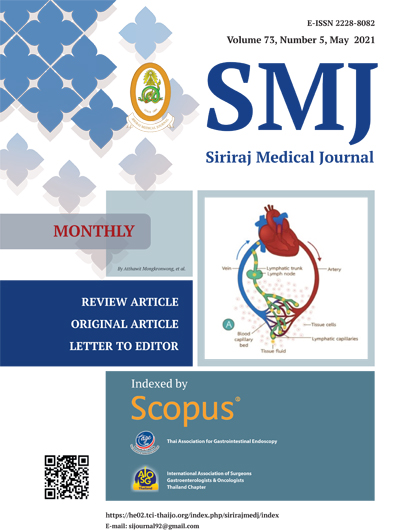Sonographic Lower Uterine Segment Thickness to Predict Cesarean Scar Defect in Pregnant Women
DOI:
https://doi.org/10.33192/Smj.2021.43Keywords:
Sonography, lower uterine segment, cesarean scar, term pregnancyAbstract
Objective: To study the validity of sonographic lower uterine segment (LUS) thickness in predicting intraoperative cesarean scar defect (CSD) and thin incision sites in term pregnancy.
Methods: This was a cross-sectional study involving 111 full-term pregnant women who were scheduled for repeat cesarean delivery from April, 2019 to January, 2020. The sonographic myometrial LUS thickness was measured prior to surgery. The cesarean scar was assessed using the morphologic classification system as either grade 1 (a normally formed LUS), grade 2 (a thin LUS, but without visible content), or grade 3 (a thin LUS with visible content). Then, the ophthalmic caliper was used to measure the incision site’s uterine-wall thickness. The correlations between the sonographic measurements and intraoperative findings were reported. The sensitivity, specificity, positive predictive value (PPV), and negative predictive value (NPV) were calculated.
Results: There were two cases (1.8%) of grade 3 CSD. The overall correlation between the sonographic and intraoperative incision-site thickness showed r=0.559 with p-value < 0.001. The sonographic cut-off value of 1.5 mm could predict CSD and a thin incision-site uterine wall with sensitivity, specificity, PPV, NPV of 50.0%, 90.8%, 9.1%, 99.0%, and 37.5%, 94.6%, 54.5%, 90.0%, respectively. A receiver operating characteristic curve was generated to determine the optimum cut-off value at 2.5 mm with a sensitivity of 76.5% and a specificity of 73.3%. The area under the curve was 0.8 (a 95% confidence interval, 0.718-0.885).
Conclusion: Abdominal sonography is a valuable tool for the preoperative prediction of CSD. A myometrial LUS thickness of more than 1.5 mm is associated with a lower likelihood of cesarean scar dehiscence.
References
2. Başbuğ A, Doğan O, Ellibeş Kaya A, Pulatoğlu Ç, Çağlar M. Does suture material affect uterine scar healing after cesarean section? results from a randomized controlled trial. J Invest Surg. 2019;32:763-9.
3. Verma U, Chandra M, Nagrath A, Singh S, Agrawal R. Assessment of cesarean section scar strength: still a challenge? Indian J Clin Pract. 2014;24:974-7.
4. Basic E, Basic-Cetkovic V, Kozaric H, Rama A. Ultrasound evaluation of uterine scar after cesarean section. Acta Inform Med. 2012;20:149-53.
5. Satpathy G, Kumar I, Matah M, Verma A. Comparative accuracy of magnetic resonance morphometry and sonography in assessment of post-cesarean uterine scar. Indian J Radiol Imaging. 2018;28:169-74.
6. Fukuda M, Fukuda K, Shimizu T, Bujold E. Ultrasound assessment of lower uterine segment thickness during pregnancy, labour, and the postpartum period. J Obstet Gynaecol Can. 2016;38: 134-40.
7. Jastrow N, Vikhareva O, Gauthier RJ, Irion O, Boulvain M, Bujold E. Can third-trimester assessment of uterine scar in women with prior Cesarean section predict uterine rupture? Ultrasound Obstet Gynecol. 2016;47:410-4.
8. Bujold E, Jastrow N, Simoneau J, Brunet S, Gauthier RJ. Prediction of complete uterine rupture by sonographic evaluation of the lower uterine segment. Am J Obstet Gynecol. 2009;201:320.e1-6.
9. Sen S, Malik S, Salhan S. Ultrasonographic evaluation of lower uterine segment thickness in patients of previous cesarean section. Int J Gynecol Obstet. 2004;87:215-9.
10. Cheung VYT, Constantinescu OC, Ahluwalia BS. Sonographic evaluation of the lower uterine segment in patients with previous cesarean delivery. J Ultrasound Med. 2004;23:1441-7.
11. Kok N, Wiersma IC, Opmeer BC, de Graaf IM, Mol BW, Pajkrt E. Sonographic measurement of lower uterine segment thickness to predict uterine rupture during a trial of labor in women with previous Cesarean section: a meta-analysis. Ultrasound Obstet Gynecol. 2013;42:132-9.
12. Gizzo S, Zambon A, Saccardi C, Patrelli TS, Di Gangi S, Carrozzini M, et al. Effective anatomical and functional status of the lower uterine segment at term: estimating the risk of uterine dehiscence by ultrasound. Fertil Steril. 2013;99:496-501.
13. Jha NNS, Maheshwari S, Barala S. Ultrasonographic assessment of strength of previous cesarean scar during pregnancy. Int J Reprod Contracept Obstet Gynecol. 2018;7:1458-63.
14. Seliger G, Chaoui K, Lautenschläger C, Riemer M, Tchirikov M. Technique of sonographic assessment of lower uterine segment in women with previous cesarean delivery: a prospective, pre/intraoperative comparative ultrasound study. Arch Gynecol Obstet. 2018;298:297-306.
15. Tazion S, Hafeez M, Manzoor R, Rana T. Ultrasound predictability of lower uterine segment cesarean section scar thickness. J Coll Physicians Surg Pak. 2018;28:361-4.
16. Jastrow N, Antonelli E, Robyr R, Irion O, Boulvain M. Inter- and intraobserver variability in sonographic measurement of the lower uterine segment after a previous Cesarean section. Ultrasound Obstet Gynecol. 2006;27:420-4.
Published
How to Cite
Issue
Section
License
Copyright (c) 2021 Siriraj Medical Journal

This work is licensed under a Creative Commons Attribution-NonCommercial-NoDerivatives 4.0 International License.
Authors who publish with this journal agree to the following conditions:
Copyright Transfer
In submitting a manuscript, the authors acknowledge that the work will become the copyrighted property of Siriraj Medical Journal upon publication.
License
Articles are licensed under a Creative Commons Attribution-NonCommercial-NoDerivatives 4.0 International License (CC BY-NC-ND 4.0). This license allows for the sharing of the work for non-commercial purposes with proper attribution to the authors and the journal. However, it does not permit modifications or the creation of derivative works.
Sharing and Access
Authors are encouraged to share their article on their personal or institutional websites and through other non-commercial platforms. Doing so can increase readership and citations.















